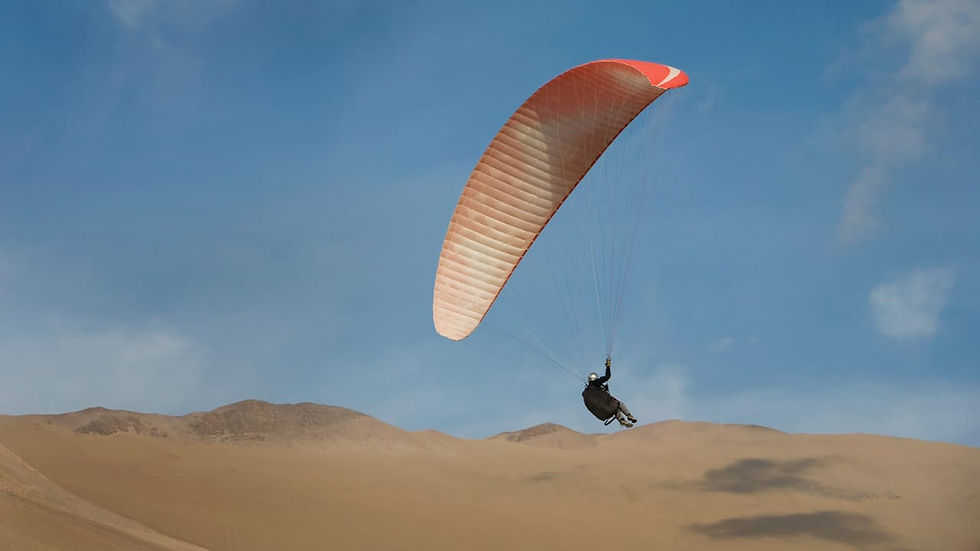Tips and Tricks for Tandem Paragliding Pilots
- Rahul Panwar

- Nov 3, 2023
- 3 min read
Updated: Dec 15, 2023

Flying tandem requires skill, knowledge, and attention to detail. As a tandem pilot, it is your responsibility to ensure the safety and comfort of your passengers throughout the flight. In this article, we will discuss some valuable tips and tricks to help tandem pilots have a successful and enjoyable flying experience.
Equipment
Choosing the right equipment is crucial for a tandem flight. Here are some important considerations:
Use a reserve that can hold 10% more weight than your total take-off weight.
Opt for an airbag harness for your passenger for added protection.
Use Inox or steel carabiners on your main attachment points for durability and strength.
Hard or Soft Spreaders
When it comes to spreaders, there are two options to consider:
Soft spreaders: These spreaders provide a more integrated feeling with your passenger, like riding a motorcycle. They also make your pack lighter and allow you to maintain a consistent position, regardless of your passenger's weight.
Hard spreaders: If you prefer more legroom and want your passenger to take advantage of weight-shifting capabilities, hard spreaders are a better choice. They allow for position shifting based on weight distribution.
Hanging Stuff
If you have additional items such as a camera, camera stick, or flag that you want to hang from your harness, it is essential to consider safety:
Hang these items on the opposite side of your reserve handle to prevent accidental deployment and interference during emergencies.
Pre-flight Checklist
Before every take-off, it is crucial to have a checklist in mind to ensure that everything is in order. Here is a suggested checklist:
Perform a pre-flight check on all attachment points, such as passenger leg straps, chest straps, helmets, and carabiners.
Count the points on your checklist and make it a habit to go through each one until it becomes an automatic procedure.
Briefing
When flying in tandem, clear communication and trust are essential. Here are some points to cover during your briefing:
Explain the flight process and reassure your passenger that their safety is your priority.
Outline the tasks that they need to perform during take-off, such as walking or running.
Emphasize the importance of trust between the pilot and the passenger.
Know Your Wing
Understanding how your tandem wing behaves in different situations is crucial for a smooth flight. Consider the following factors:
Learn the speed at which your wing ascends and descends.
Understand the amount of brake input required and the wing's tolerance before stalling.
Familiarize yourself with the wing's response to side corrections.
Take-off Techniques
Take-off can be a critical phase of the flight. Here are some tips to ensure a successful take-off:
If you perform a reverse launch, ensure that you turn in the opposite direction of your reserve handle. This helps avoid accidental reserve deployment.
In low or no wind conditions, set your canopy in a C shape. This ensures faster inflation and helps maintain stability during take-off.
During the countdown for take-off, wait for your passenger to start walking first. This creates tension in the system and helps the passenger feel secure.
In-flight Tips
Once in the air, there are several actions you can take to enhance the flight experience:
Hold on to your brake handles throughout the flight. This allows you to perform tasks such as adjusting your passenger or setting up your camera without compromising safety.
Inform your passenger about turns before applying the brakes. This helps them anticipate the movement, reducing the chances of motion sickness.
Engage in constant communication with your passenger to ensure their comfort and well-being.
Landing Best Practices
A smooth landing is crucial to complete the flight safely. Consider the following tips:
Plan your landing approach to be as tangential as possible, gradually descending towards the ground.
Before the final approach, instruct your passenger to lift their feet and wait for your signal to stand. This helps avoid accidental falls or collisions.
Set your trimmer to medium speed during landing. This allows for better control and prevents ballooning when backpedaling is ineffective in strong winds.
Support your passenger during touchdown by using your arms while maintaining control of your brakes.
By following these tips and tricks, you can ensure a safe and enjoyable flying experience for both you and your passenger. Practice them on your solo wing and continue to refine your skills as a tandem pilot. Fly high, have fun, and always prioritize safety!





Where can I check out more about this sport? I love betting and might want to make my predictions for a change. Also, what do you think of similarly themed games? In Chennai was where I first saw how game mechanics affect the score. Later I registered at 1win india and my profit doubled, because I wasted no time on manual statistics. I am not rich, so I started with the minimum deposit of 300 rupees, but as I told you, I rolled over as fast as a cricket ball, so I learned fast and increased my winnings. But I would be nothing without others experience, so please tell me about yours.